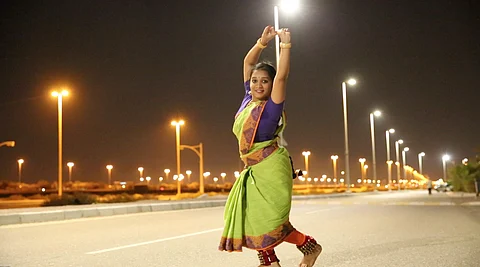

Sangavi Prasad, a lone classical dancer spent a week scouting for the perfect locations for her to dance in the streets of Abu Dhabi. The Coronavirus was in full swing and the city was solemnly observing the month of Ramadan. So she had to carefully find places strategically near her home where she could unleash her craft. Halfway across the world, director Tijo Thankachan was in conversation with her on a video calling app where he picked out the best locations and the ideal spots to place the camera. The idea was to bring life into a song that told the tales of brave health workers across the world.
Tijo received the song 'Malaika' from artists Suresh Nandan and Abhi Barnabas. He says, "Sangavi was a junior in college and one of the most brilliant dancers I have known. Although we had planned a lyrical video or something of that sort initially, I knew she would do more justice to what the song represented. So I reached out to her and she immediately agreed. It was an added bonus that her family was also extremely supportive."
A few days before they recorded it, playback singer Gayathri Suresh sent over her rendition of the song and they fused in the female version of it overnight. Absolutely satisfied with their creation, they instructed Sangavi over the phone and took them along to the locations that she found most interesting. They found empty roads, abandoned parks and street corners to shoot the video. Over the course of 5 days, a relative of Sangavi's shot the video on a Canon EOS 5D Mark III while Tijo directed it over a video conference platform and edited it further.
"Since we were in the middle of so many things, there were a lot of expected and unexpected constraints," admits Tijo. "The virus and Ramadan meant that we had very few windows to go to the locations and everything had to be done before 10am or the sun's glare literally covered everything else. So everything had to be prepped and finished within 6 to 9 am. The camera was all done between 6-9 am. The shakes and any other effects were added later manually," he says.
